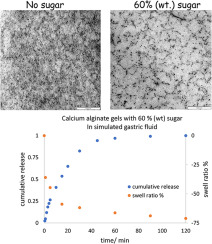当前位置:
X-MOL 学术
›
Food Hydrocoll.
›
论文详情
Our official English website, www.x-mol.net, welcomes your feedback! (Note: you will need to create a separate account there.)
High sugar content impacts microstructure, mechanics and release of calcium-alginate gels
Food Hydrocolloids ( IF 10.7 ) Pub Date : 2018-11-01 , DOI: 10.1016/j.foodhyd.2018.05.029 Patricia Lopez-Sanchez , Nils Fredriksson , Anette Larsson , Annika Altskär , Anna Ström
Food Hydrocolloids ( IF 10.7 ) Pub Date : 2018-11-01 , DOI: 10.1016/j.foodhyd.2018.05.029 Patricia Lopez-Sanchez , Nils Fredriksson , Anette Larsson , Annika Altskär , Anna Ström

|
The use of calcium-alginate gels as carriers of food and pharmaceutical compounds is of great interest due the versatile properties of such systems. In this work, we investigated the influence of sugars (glucose: fructose) as cosolutes (15-60% (wt)) on the physico-chemical properties of calcium-alginate gel particles. Sugar concentrations above 15% (wt) reduced extensibility of alginate molecules, as shown by intrinsic viscosity measurements, and lead to a more open or less connected gel network with aggregated alginate strands. Furthermore, it is shown for the first time that sugar impacted swelling-deswelling ability of calcium alginate gels under simulated gastric (pH 1.2) and intestinal (pH 6.6) conditions. Release of sugar from calcium alginate gels with 15% (wt) and 30% (wt) sugar was close to Fickian diffusion mechanism, in both simulated gastric and intestinal fluid, with diffusion coefficient close to that previously reported for calcium-alginate gels with lower sugar contents. However, release from 60% (wt) gels in gastric fluid was slower than for 15 and 30% (wt) and, there was a drastic shrinkage of the gels under acid conditions. In intestinal fluid 60% (wt) gels showed slower release than gels with lower sugar content, this was hypothesised to be due to the lower surface area of these gels. Understanding the structure-function relationship of these gels is key to the successful design of delivery systems for food and biotechnological applications.
中文翻译:

高糖含量影响海藻酸钙凝胶的微观结构、力学和释放
由于此类系统的多功能特性,使用海藻酸钙凝胶作为食品和药物化合物的载体引起了人们极大的兴趣。在这项工作中,我们研究了糖(葡萄糖:果糖)作为共溶质(15-60% (wt))对海藻酸钙凝胶颗粒理化性质的影响。糖浓度高于 15% (wt) 会降低海藻酸盐分子的延伸性,如特性粘度测量所示,并导致凝胶网络更加开放或连接更少,海藻酸盐链聚集。此外,首次表明在模拟胃 (pH 1.2) 和肠道 (pH 6.6) 条件下,糖会影响海藻酸钙凝胶的溶胀-消肿能力。从含有 15% (wt) 和 30% (wt) 糖的海藻酸钙凝胶中释放糖接近 Fickian 扩散机制,在模拟胃液和肠液中,扩散系数接近先前报道的含糖量较低的海藻酸钙凝胶。然而,胃液中 60% (wt) 凝胶的释放慢于 15% 和 30% (wt),并且在酸性条件下凝胶急剧收缩。在肠液中,60% (wt) 的凝胶比含糖量较低的凝胶释放得更慢,这被假设是由于这些凝胶的表面积较小。了解这些凝胶的结构-功能关系是成功设计用于食品和生物技术应用的递送系统的关键。胃液中 60% (wt) 凝胶的释放比 15% (wt) 和 30% (wt) 慢,并且在酸性条件下凝胶急剧收缩。在肠液中,60% (wt) 的凝胶比含糖量较低的凝胶释放得更慢,这被假设是由于这些凝胶的表面积较小。了解这些凝胶的结构-功能关系是成功设计用于食品和生物技术应用的递送系统的关键。胃液中 60% (wt) 凝胶的释放比 15% (wt) 和 30% (wt) 慢,并且在酸性条件下凝胶急剧收缩。在肠液中,60% (wt) 的凝胶比含糖量较低的凝胶释放得更慢,这被假设是由于这些凝胶的表面积较小。了解这些凝胶的结构-功能关系是成功设计用于食品和生物技术应用的递送系统的关键。
更新日期:2018-11-01
中文翻译:

高糖含量影响海藻酸钙凝胶的微观结构、力学和释放
由于此类系统的多功能特性,使用海藻酸钙凝胶作为食品和药物化合物的载体引起了人们极大的兴趣。在这项工作中,我们研究了糖(葡萄糖:果糖)作为共溶质(15-60% (wt))对海藻酸钙凝胶颗粒理化性质的影响。糖浓度高于 15% (wt) 会降低海藻酸盐分子的延伸性,如特性粘度测量所示,并导致凝胶网络更加开放或连接更少,海藻酸盐链聚集。此外,首次表明在模拟胃 (pH 1.2) 和肠道 (pH 6.6) 条件下,糖会影响海藻酸钙凝胶的溶胀-消肿能力。从含有 15% (wt) 和 30% (wt) 糖的海藻酸钙凝胶中释放糖接近 Fickian 扩散机制,在模拟胃液和肠液中,扩散系数接近先前报道的含糖量较低的海藻酸钙凝胶。然而,胃液中 60% (wt) 凝胶的释放慢于 15% 和 30% (wt),并且在酸性条件下凝胶急剧收缩。在肠液中,60% (wt) 的凝胶比含糖量较低的凝胶释放得更慢,这被假设是由于这些凝胶的表面积较小。了解这些凝胶的结构-功能关系是成功设计用于食品和生物技术应用的递送系统的关键。胃液中 60% (wt) 凝胶的释放比 15% (wt) 和 30% (wt) 慢,并且在酸性条件下凝胶急剧收缩。在肠液中,60% (wt) 的凝胶比含糖量较低的凝胶释放得更慢,这被假设是由于这些凝胶的表面积较小。了解这些凝胶的结构-功能关系是成功设计用于食品和生物技术应用的递送系统的关键。胃液中 60% (wt) 凝胶的释放比 15% (wt) 和 30% (wt) 慢,并且在酸性条件下凝胶急剧收缩。在肠液中,60% (wt) 的凝胶比含糖量较低的凝胶释放得更慢,这被假设是由于这些凝胶的表面积较小。了解这些凝胶的结构-功能关系是成功设计用于食品和生物技术应用的递送系统的关键。



























 京公网安备 11010802027423号
京公网安备 11010802027423号